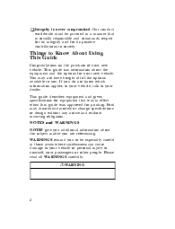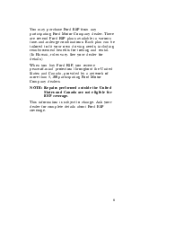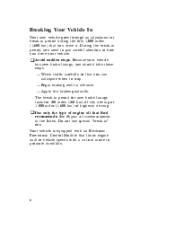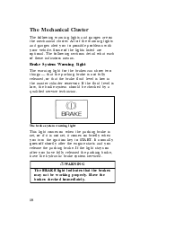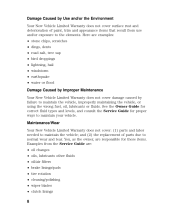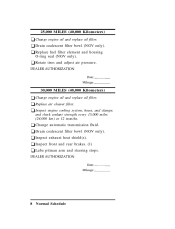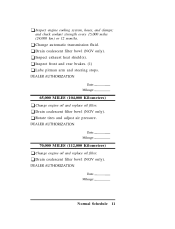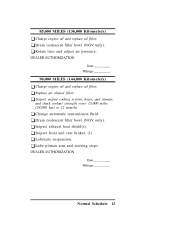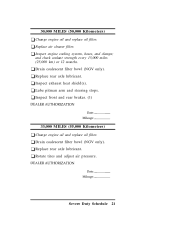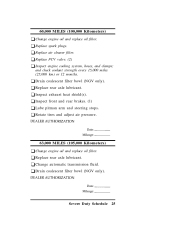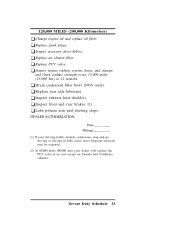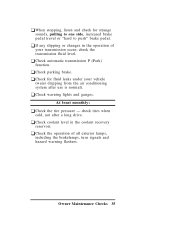1997 Ford Crown Victoria Support Question
Find answers below for this question about 1997 Ford Crown Victoria.Need a 1997 Ford Crown Victoria manual? We have 4 online manuals for this item!
Question posted by deecallow86 on September 3rd, 2013
My 97 Crown Vic Has A Brake System I've Never Seen Before. How Do I Change Them?
Current Answers
Answer #1: Posted by RudRaid on September 3rd, 2013 6:10 AM
CALIPER/BRAKE PAD REMOVAL
- Check fluid level in brake master cylinder reservoir. Remove brake fluiduntil brake master cylinder reservoir is half-full. Discard removed fluid.
- Raise and support vehicle.
- Remove wheel and tire. Use care to avoid damage to wheel cylinder bleeder screw or rotor shield. NOTE:It is not necessary to disconnect hydraulic connections.
- Remove two caliper guide pin bolts.
- Lift disc brake caliper away from front disc brake rotor using a rotating motion.
- Support the disc brake caliper assembly in a manner that will not stretch or damage the front brake hose, such as hanging from an S-hook or mechanics wire.
- Remove brake shoe and lining assemblies from disc brake caliper anchor plate by sliding brake shoe and lining to off of front disc brake caliper anchor plate.
- Inspect both disc brake rotor braking surfaces. Minor scoring or buildup of brake shoe and lining material does not require machining or replacement of the front disc brake rotor.
- Hand-sand glaze off both front disc brake rotor braking surfaces using garnet paper 100A (medium grit) or aluminum oxide 150-J (medium grit).
ROTOR REMOVAL
- If rotor is not going to be machined off of the vehicle, mark the front disc brake rotor and one lug nut with touch-up paint to aid assembly.
- Remove two caliper anchor plate bolts and discard.
- Remove caliper anchor plate. NOTE:If excessive force must be used during front disc brake rotor removal, the front disc brake rotor should be checked for lateral runout prior to installation.
- Remove front disc brake rotor assembly from wheel hub.
- If additional force is required to remove front disc brake rotor;
- apply Rust Penetrant and Inhibitor F2AZ-19A501-A or equivalent meeting Ford specification ESR-M99C56-A on disc brake rotor/hub mating surfaces.
- First, strike front disc brake rotor between studs with a plastic hammer.
- If this does not work, attach 2/3-Jaw Puller D80L-1013-A or equivalent and remove front disc brake rotor.
ROTOR INSTALLATION NOTE: Remove protective coating from new front disc brake rotor with Metal Brake Parts Cleaner (Non-Chlorinated). If original front disc brake rotor is being installed, make sure rotor braking and mounting surfaces are clean. Hand-sand braking surfaces as necessary as described. Apply a small amount of Silicone Brake Caliper Grease and Dielectric Compound to hub mounting surface and pilot diameter of front disc brake rotor to ease future removal.
- Clean rust, scale or dirt off of the hub mounting surface of the front disc brake rotor as well as the hub mounting surface. The contamination will not allow front disc brake rotor to sit flat to the hub surface.
- If the front disc brake rotor is being replaced, remove the protective coating from the new front disc brake rotor with Metal Brake Parts Cleaner (Non-Chlorinated) F5AZ-2G410-AA or equivalent.
- Lubricate the hub mounting surface with Silicone Brake CaliperGrease and Dielectric Compound and install the front disc brake rotor on the wheel hub.
- Install disc brake caliper anchor plate assembly onto front disc brake rotor and align index marks.
- Install two new caliper anchor plate mounting bolts and tighten to 170-230 Nm (125-169 ft. lbs.) .
- Use a 10 cm (4 inch) C-clamp and wood block 70 mm x 25 mm (2 3/4 inch x 1 inch) and approximately 19 mm (3/4 inch)thick to seat caliper piston in its bore. This must be done to provide clearance for disc brake caliper assembly to fit over front disc brake rotor and pads during installation.
- Install disc brake pads to front disc brake caliper anchor plate.
- Make sure disc brake pad anti-rattle spring and disc brake pad anti-rattle clip is seated in caliper inspection opening. Disc brake pad anti-rattle clip must be installed from the lining side.
- Inspect disc brake caliper locating pin and locating pin boots. If disc brake caliper locating pin is binding, remove and clean. Lubricate with Silicone Brake CaliperGrease and Dielectric Compound. If boots are torn, replace.
- Install front disc brake caliper onto rotor and pads.
- Install caliper guide pin bolts. Tighten lower bolt first to 28-36 Nm (21-26 ft. lbs.) . Tighten upper bolt to 28-36 Nm (21-26 ft. lbs.).
- Inspect disc brake caliper/front disc brake caliper anchor plate assembly to make sure brake shoes and linings are properly installed. CAUTION:Failure to tighten lug nuts in a star pattern may result in high rotor runout which will speed up the development of brake roughness, shudder and vibration.
- Install wheel and tire assembly, using Rotunda Accutorq Lug Nut Sockets or equivalent on 1/2 inch drive air impact wrench or torque wrench to tighten lug nuts to 115-142 Nm (85-104 ft. lbs.).
- Check rotor lateral runout. Refer to Testing and Inspection . See: Testing and Inspection\Runout\Front Runout must not exceed 0.05 mm (0.002 in) . If runout is exceeded, remove front disc brake rotor and reindex one position on wheel hub and reinstall. Repeat until runout is within specification. If runout cannot be corrected, machine rotor. Refer to Refinishing . See: Refinishing
- Lower vehicle.
- Pump brake pedal several times to position brake shoes and linings. Refill brake master cylinder with high performance Dot-3 Motor Vehicle Brake Fluidas necessary.
- Road test vehicle.
Supporting Images
You can click the images below to enlargeRelated Manual Pages
Similar Questions
after the fuel pump goes out






